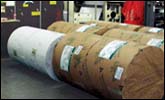
Pulp, Paper, and Paperboard Mills
The manufacture of pulp and paper is one of the world's oldest and largest industries. Pulp, paper, and paperboard mills in the United States are a world leader in the production of pulp and paper. According to the U.S. EPA, these mills produce 9 million tons of pulp annually and 26 billion newspapers, books, and magazines. They are one of the nation's largest industries made up of approximately 565 manufacturing facilities located in 42 states and employ over 200,000 people. Pulp and paper manufacturing can also be very hazardous due to massive weights and falling, rolling, and/or sliding pulpwood loads. Workers may be struck or crushed by loads or suffer lacerations from the misuse of equipment, particularly when machines are used improperly or without proper safeguards. Pulp, paper, and paperboard mills are addressed in specific standards for the general industry. OSHA Standards This section highlights OSHA standards, directives (instructions for compliance officers), and standard interpretations (official letters of interpretation of the standards) related to pulp, paper, and paperboard mills. Note: Twenty-five states, Puerto Rico and the Virgin Islands have OSHA-approved State Plans and have adopted their own standards and enforcement policies. For the most part, these States adopt standards that are identical to Federal OSHA. However, some States have adopted different standards applicable to this topic or may have different enforcement policies. Frequently Cited Standards A listing of the most frequently cited standards by Federal OSHA for Paper Mills Industry Group (SIC code 2620) is available. Other Highlighted Standards
Directives
Standard Interpretations
Hazards and Solutions The following references aid in recognizing hazards in the workplace and provide examples of possible solutions. General
Noise
Machine Guarding
Lockout/Tagout
Pressure Vessels
Additional Information Related Safety and Health Topics Pages Other Resources
Accessibility Assistance: Contact the OSHA Directorate of Technical Support and Emergency Management at (202) 693-2300 for assistance accessing PDF materials. |

 Newsletter
Newsletter RSS Feeds
RSS Feeds Print This Page
Print This Page
 Text Size
Text Size

